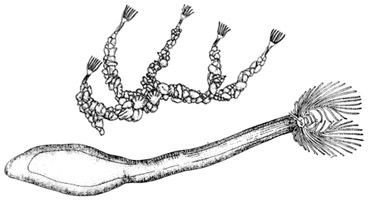
Phoronida
Phoronids are a very small phylum containing 12 species of generally small marine worms. They live in burrows lined with secreted tubes, mostly in shallow coastal waters. Though they are normally long (up to 50cm / 30 in) Phoronids are normally very thin. Some species can dissolve away holes in rocks such as limestone, calcareous seashells or even cement piers, they then live in these holes which they line with their secreted tubes. Sediment particles are added to the chitinous tube to stiffen it.

The Phoronan body, like the body's of the other lophophorates has 3 main sections. . However in Phoronans, the anterior or front section is highly reduced. In Phoronans it consists only of a small lid which guards the oral cavity. The main portions of the body are the mesosoma and metasoma which are separated internally by a septum. The mesosoma is the lophophore, normally the only part of the animal which is visible.
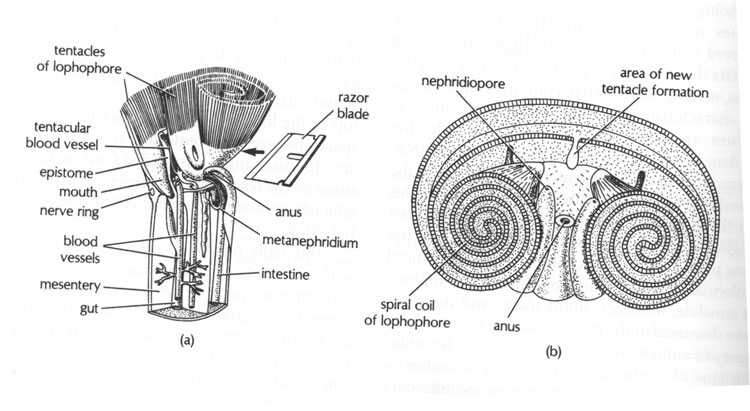
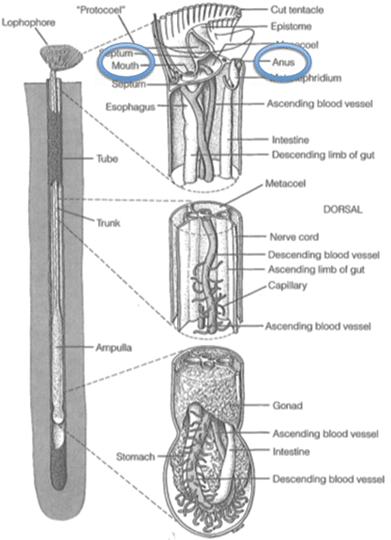
The digestive tract of Phoronans consists of a short esophagus which leads into a spherical stomach and then into the intestines which end in the anus.
Phoronans have a simple blood system comprising a single descending artery and ascending vein linked by a network of fine capillaries. There are also blood vessels into each of the tentacles. The blood of Phoronans is colorless but contains corpuscles with a hemoglobin like pigment which helps in carrying oxygen.
The video below shows circulation in phoronans.
The tentacles act as gills or organs of gaseous exchange, as well as being used for feeding, therefore the blood gains oxygen and loses carbon dioxide while it is passing through them. Metabolic wastes are extracted from the blood by means of a pair of tubular metanephridia situated on either side of the hindgut. The nervous system of Phoronids consists of a diffuse network of nerve which cover the entire body.
Phoronans are mostly hermaphroditic, but the sexes are separate in a few species. Some species lay only a few (12 - 25) large eggs which have a lot of yolk. These eggs are brooded within the adults tube, they are released only when they have hatched. They do not feed and spend only about 4 days in the plankton as larvae. Then they sink to the sea floor where, after a further 3 days they become permanently attached. Here they soon metamorphose into a small adult.
The second strategy is to lay a much larger number (up to 500)of smaller eggs. These eggs are released as soon as they are fertilized. They hatch a few days later into what is called an 'actinotrocha' larvae. This free swimming and feeding larvae remains a part of the seas plankton for about 3 weeks before it too sinks to the sea floor and undergoes metamorphosis.

Brachiopods
Brachiopods are small animals with the largest living species having a shell length of about 10 cm (4 in). However there are over 30,000 fossil species. They were quite a diverse group by the beginning of the Cambrian 600 mya (million years ago)., Some living species today appear much like their fossil ancestors. Modern Lingula ungius look almost identical to their Paleozoic ancestors of 400 mya. Phoronids at once thought to be derived from brachiopods or an ancestor that gave rise to brachiopods and shell less phoronids. Now this view is debated but molecularly brachiopods are more related to phoronids than to bryozoans.
The shell is composed of about 50% calcium carbonate or phosphate which the animal extracts from the sea water. The rest of the shell is composed of either chitin or protein. The shells grow continually throughout the animals life, new material is laid down along the larger rounded edge of the shell (called the 'margin') by the cellular epithelium. The two halves of the shell are normally not equal.
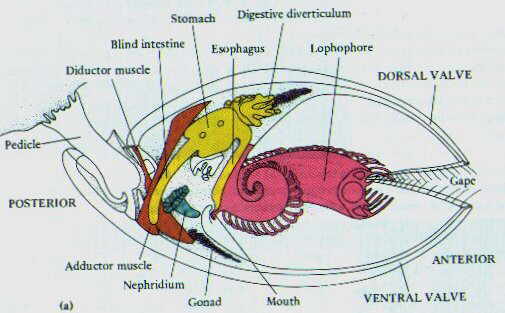
The cellular epithelium that lines the internal surface of both halves of the shell has two layers, the inner layer is called the mantle. This separates the outer portion of the shell which contains the lophophore from the inner section which contains the rest of the animals body. Thus the space inside the shell is divided into two halves, the mantle cavity and the body cavity or coelomic cavity. The body cavity is generally smaller than the mantle cavity.
Within the body or coelomic cavity there is a fluid which contains blood corpuscles. These blood corpuscles contain a respiratory pigment called hemerythrin, which like haemoglobin contains iron. These cells carry oxygen to the various parts of the body and take the carbon dioxide away. There are canals within the body through which this coelomic fluid flows, but it is not a true blood system and there is only one blood vessel (heart) which has muscular walls and beats once every 30 to 40 minutes to keep the fluid circulating around the body. Metabolic wastes are collected from wandering cells called coelomocytes, which collect nitrogenous material through the body, and released into the nephridia.
The nervous system is fairly similar in all species and consists of ring of nerves which encircles the esophagus. From this ring a few other nerves reach out into the mantle, the lophophore and the muscles.
All brachiopods reproduce sexually, generally with separate sexes and approximately equal sex ratios (where known), but a few may be hermaphroditic. Gametes are sometimes released into the open water , though in many species the ova or eggs are retained within the coelomic cavity where they can be brooded and protected for a variable length of time
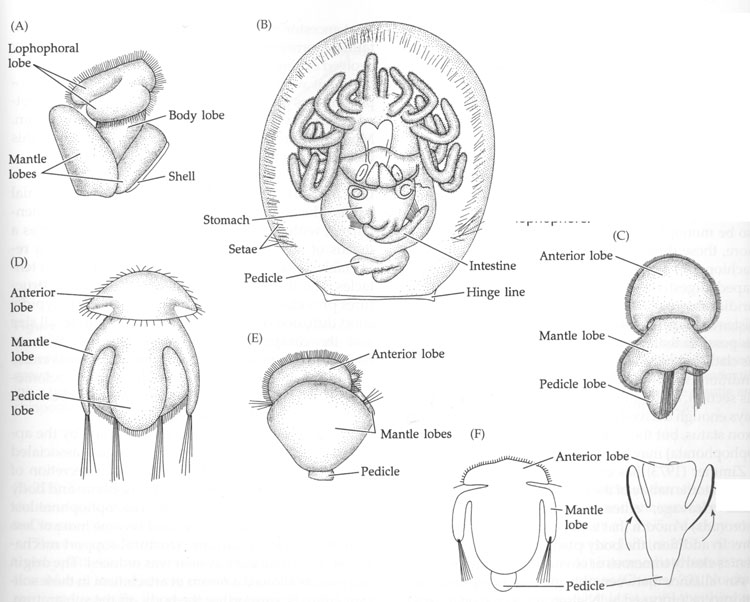
Taxonomically the Brachiopoda are divided into two major groups, the Articulata and the Inarticulata on the basis of the shell structure. The Articulata are distinguished by the presence of teeth and a definite hinge where the two valves meet at their lower edge. There is therefore an 'articulation' between the two shells and the pedicle (substrate anchor) passes through a hole in the ventral valve. The Inarticulata have no teeth or special hinge and the pedicle, when present, passes between the two valves of the shell.
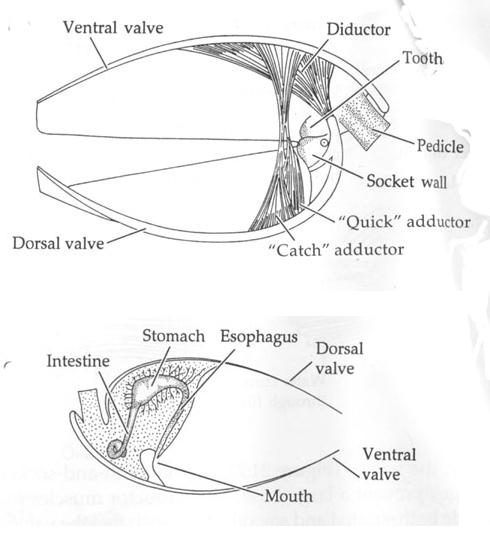
Brachiopods are among the earliest shelly fossils to appear in the Cambrian and are common fossils throughout the Paleozoic because they were among the dominant filter feeders until the Permian–Triassic mass extinction, when their diversity fell by about two-thirds to a new, fairly stable level . When brachiopods were at their peak, before the rise of molluscs and corals, they were among the principal reef builders in shallow seas.
Kamptozoa
These small animals have a tentacled crown on a body with a long stalk, and are usually colonial and connected by stolons. Similar to bryozoans, they feed by capturing particles on the tentacles. However, cilia beat in the opposite direction to how they operate in bryozoans, drawing the ciliary currents upward through the crown. Note that although their own tentacles can generate feeding currents, these animals often take advantage of currents created by other animals (and can often be seen near the out current siphons of tunicates and sponges. The anus is found among the tentacles, so the crown is technically not a lophophore. although they are considered part of the clade Lophotrochozoa.

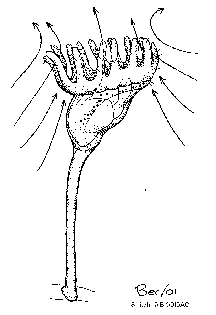
Unlike bryozoa, cleavage is determinate and spiral in Kamptozoa.
| Entoprocta | Bryozoa (Ectoprocta) | |
|---|---|---|
| Tentacles | Solid | Hollow |
| Feeding current | From bases to tips of tentacles | From tips to bases of tentacles |
| Position of anus | Inside "crown" of tentacles | Outside "crown" of tentacles |
| Coelom | none | Three-part |
| Shape of founder zooid in a colony | Same as other zooids | Round, unlike normal zooids] |
| Metamorphosis to adult | Retains most larval structures | Destroys most larval structures |